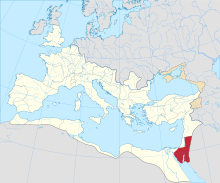
Back Arabia Petraea Afrikaans البتراء العربية Arabic Аравія Петрэйская Byelorussian Арабия (римска провинция) Bulgarian আরাবিয়া পেট্রাইয়া Bengali/Bangla Arabia Petraea Breton Aràbia Pètria Catalan Arabia Petraea Czech Arabia Petraea Welsh Arabia Petraea Danish
This article needs additional citations for verification. (March 2016) |
| Provincia Arabia Petraea Ἐπαρχία Πετραίας Ἀραβίας العَرَبِيَّة الصَخْرِيِّة | |||||||||||||
|---|---|---|---|---|---|---|---|---|---|---|---|---|---|
| Province of Roman Empire, Byzantine Empire | |||||||||||||
| 106–630s | |||||||||||||
 The Roman Empire c. 125 AD, with the province of Arabia Petraea highlighted. | |||||||||||||
| Capital | Petra, Bostra | ||||||||||||
| History | |||||||||||||
• Roman conquest | 106 | ||||||||||||
• Palaestina Salutaris established | 390 | ||||||||||||
| 630s | |||||||||||||
| |||||||||||||
Arabia Petraea or Petrea, also known as Rome's Arabian Province[1] or simply Arabia, was a frontier province of the Roman Empire beginning in the 2nd century. It consisted of the former Nabataean Kingdom in the southern Levant, the Sinai Peninsula, and the northwestern Arabian Peninsula. Its capital was Petra. It was bordered on the north by Syria, on the west by Judaea (merged with Syria from AD 135) and Egypt, and on the south and east by the rest of Arabia, known as Arabia Deserta and Arabia Felix.
The territory was annexed by Emperor Trajan, like many other eastern frontier provinces of the Roman Empire, but held onto, unlike Armenia, Mesopotamia and Assyria, well after Trajan's rule, its desert frontier being called the Limes Arabicus. It produced the Emperor Philippus, who was born around 204. As a frontier province, it included a desert populated by Arabic tribes, and bordering the Parthian hinterland.
Though subject to eventual attack and deprivation by the Parthians and Palmyrenes, it had nothing like the constant incursions faced in other areas on the Roman frontier, such as Germany and North Africa, or the entrenched cultural presence that defined the other more Hellenized eastern provinces.
- ^ (Latin: Provincia Arabia; Arabic: العربية الصخرية; Ancient Greek: Ἐπαρχία Πετραίας Ἀραβίας)